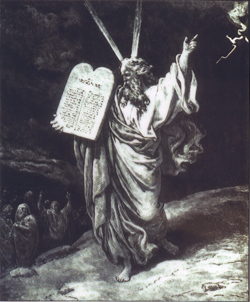By Binyamin Kagedan/JNS.org

Religion and language interact in curious ways. Language, as the modern theorists have understood it, is in essence a culturally bounded system by which we decide and establish that one thing is not another thing. Language creates mental categories of difference that we typically take for granted; for example, that a chair is different from a table, that aqua is different from turquoise, that joy is different from happiness, which is different from pleasure.
Religions too, as anthropologist Mary Douglas is famous for pointing out, seem to thrive on the elaboration and observance of categories of difference, both within religious communities and especially between them. This year, Passover and Easter were celebrated at the same chronological moment by English-speaking Jews and Christians, respectively. Though they share certain historical and thematic elements, the fact that these two holidays sport utterly different names in English bars any conceptual confusion. (You will note, however, that in Spanish, the word for both holidays is “Pascua.”) But early in June 2014, the Jewish and Christian liturgical cycles will almost collide again when both groups observe a holiday called Pentecost. That these two things share a word in our language naturally leads us to ask: Are they the same or different?
The word Pentecost was originally the Greek name for Shavuot, the biblical feast of the grain harvests. It literally means “the 50th,” referring to the fact that the holiday is scheduled exactly seven weeks, thus 50 days, after the beginning of Passover. This stretch of time encompassed the country-wide harvest season of Ancient Israel, beginning with the offering of fresh barley and ending with the offering of bread baked from newly gathered wheat (Leviticus 23 15:18). The Torah prescribes the counting of these 50 days of omer (wheat offering) as they pass, a ritual that continues to be observed by religious Jews in spite of the disappearance of Temple worship.
Most Jews today also identify the Jewish Pentecost as the date on which the Ten Commandments were revealed to Moses on Mt. Sinai. In fact, the bible itself draws no overt connection between the two events. The notion that Shavuot/Pentecost commemorates the giving of the Torah was actually popularized by the Rabbis of the Talmud, based on an interpretive calculation of the exact date of the exodus from Egypt. Since the bible gave only agricultural and sacrificial associations for the holiday, the revelation tradition became its central focus for generations of Jews practicing in the post-Temple era.
The Christian celebration of Pentecost has its roots in the New Testament Book of Acts. In Acts 2:1-4, a scene unfolds in which the original one hundred twenty or so original Galilean followers of Jesus are gathered together in Jerusalem on the day of Pentecost (since they were all Jews, we can assume that this indeed refers to the biblical feast of Shavuot). All of sudden, a mighty wind blew into the house and fire in the shape of tongues appeared, resting over the head of each individual. All in attendance began to speak in world languages they had never heard before, their ideas about Christ suddenly becoming intelligible to the international crowd in the surrounding area.
Today’s Christian Pentecost commemorates this descent of the Holy Spirit onto the faithful, and the consequent spreading of the gospel. Its observance varies between the different branches of Christianity, but typically includes special hymns and liturgical vestments, as well as the use of flowers and other plant life in decorating sacred spaces. Mirroring biblical tradition, Pentecost was set by church authorities to fall on the seventh Sunday following Easter, that is, 50 days later.
Thinking about the relationship between Jewish Pentecost and Christian Pentecost illuminates for us one small lineage in the evolution of the Abrahamic faiths. Consider how the concept of Pentecost was imagined and reimagined within each of the three frameworks we have discussed, adapting each time to a new set of spiritual conditions: for the agrarian ancient Israelites, as a celebration of gratitude for a successful harvest; for the exiled Rabbinic Period Jews of late antiquity, as an annual renewal of the covenant forged at Sinai; and for the early Christians—presumably inspired by the Rabbinic understanding of the holiday—as the miraculous opening of their sacred narrative to the diverse peoples of the world.
Analysis aside, I happily wish Jews and Christians alike a joyous and meaningful Pentecost this June!
*
Binyamin Kagedan has an MA in Jewish Thought from the Jewish Theological Seminary of America. He can be reached at bkagedan@gmail.com. … Preceding provided by JNS.org, which is sponsored on the pages of San Diego Jewish World through the generosity of Dr. Bob and Mao Shillman